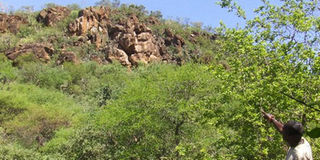Paradise off the beaten path

Kudu Hills in Elangata Wuas. Photo/RUPI MANGAT
What you need to know:
- A delightful hike through the vast Elangata Wuas plains
Whizzing past the Elangata Wuas plains en route from Nairobi to Namanga, one catches a glimpse of the sacred Maasai mountain, Ol Donyo Lengai, and the Noonkujit swamp, where herds of elephant cross over from Tanzania to browse on the lush grass.
But there is much more than meets the eye.
Hidden beyond the steep rugged rocks and the acacia-littered plains that stretch into infinity is a gem that only those who dare venture off the beaten path will find. Until roughly a decade ago, few dared to venture off the main highway.
But the few who did found a paradise that could be sustained through eco-tourist ventures with a low footprint. The hills were home to the lesser kudu - a large antelope with spiralling horns, elephants, giraffes and gerenuks, impalas and gazelles, cheetah and leopards, baboons and monkeys, and more than 260 species of birds and 300 species of trees.
In the late 1990s, with support from the Kenya Wildlife Service (KWS), Ford Foundation, and IDRC, workshops were held to map a way to help the community open up their beautiful land for eco-tourism and other sustainable projects.
This was the beginning of the Elangata-Wuas Ecosystem Management Programme. The programme has since struggled through thick and thin but with many successes, among them conserving the once endangered African wild dog, which is now sighted regularly.
There are also fewer trees cut for charcoal, a simple tourist lodge aptly named Kudu Hills has been constructed, and recently the first library in the area — the Elangata Wuas Resource Centre — supported by Africa Soma was put up and opened to the local community.
Hikers’ paradise
As we hike to the river, one of the first community guides and parataxonomist (he takes inventory of the animals), Ezekiel Roimen, points out air plants (epiphytes) that live off the host tree, the spoor of a hyena, and in the low scrub, the tiny dik diks.
We spot barbets, lilac-breasted rollers, canaries, sunbirds, but unfortunately, without a pair of binoculars, we miss out on the birds of the high skies. After straining our eyes for a couple of minutes, we make out the African crowned eagle perched on an acacia tree high up the rocky mountain. It is Africa’s most powerful bird of prey, with talons strong enough to grab a small gazelle.
Uncertain future
While everything looks good at the moment, Roimen is uncertain about the future.
“In 2000, the land was subdivided after the landowners received title deeds,” he explains. There has been change since. In what was once a common grazing ground for the clan’s livestock, there are more fences and brick houses coming up as the modern Maasai embrace the changing times. With increasing human population and land inheritance, the land will be subdivided.
“If we don’t come together to form a conservancy, all this will end,” says Roimen.
This is not a novel idea; community conservancies are increasingly popular in Kenya and across Africa as the appreciation of wildlife and other natural resources as valuable assets grows.
Whereas communities were once divorced from wildlife conservation, seeing it as a function of the government to which the national parks belonged, research from the 1970s led to a shift in approach.
Studies showed that more than 75 per cent of the wildlife was on community land, thus giving communities the onus to establish wildlife conservancies on their land in partnership with investors who would then build roads and lodges, hire wildlife personnel, and offer training, research, and exchange programmes for the benefit of the local communities.
Many have established umbrella bodies like the Northern Rangelands Trust (NRT) to help communities establish wildlife conservancies.
Stay at Kudu Hills Camp
Kudu Hills camp is located 115Km from Nairobi and is slightly past Kajiado (Nbo-Kajiado 80kms). Turn right at the sign reading Kudu Hills. It is 35 kilometers in into the road. The Kajiado-Magadi railway line cuts across and Mile 46, the Maasai trading center, is at the halfway point.
The plains are great for hiking and you can try different circuits on subsequent visits. Try the Emarti, Karero or Kudu hills, and make sure to take a local guide along.
For overnight trips camp or stay in the Maasai-styled enkaji. It costs Sh400 per person per night (half price for the kids). Beddings are provided, and there are showers and toilets – nothing fancy but it is great value for money.
The common kitchen is complete with pots and pans, cutlery and crockery. Just take your food and personal items as well as a hat and plenty of water.
Call Joel Magadi 0715 341 306 to book at Kudu Hills and Anthony Mutua on 0721 570 049 for more information on the African wild dog.




